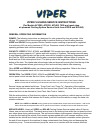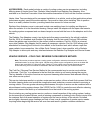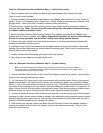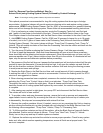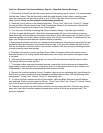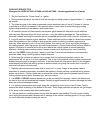ACCESSORIES: Each model includes a variety of cooling system service accessories, including
differing sizes of Heater Hose Tees, Radiator Hose Adapters and Radiator Cap Adapters. Also
available is an Overflow Evacuation Hose that enables evacuation of fluid from the overflow container.
Heater Hose Tees are designed for permanent installation in a vehicle, such as fleet applications where
technicians regularly service the same vehicles. Care must be taken when installing Tees to position
them in an easily reached location, providing hassle-free access for future services.
Radiator Hose Adapters come in pairs and include one matching hose for installing an Adapter to
either the radiator or to the thermostat housing. Always install the adapter with the open side towards
the cooling system component and use hose clamps to secure both the hose to the adapters and to the
vehicle.
The Radiator Cap Adapters come in two styles and allow easy connection to the vehicle’s radiator.
Part No. 5016 is a threaded style Radiator Cap Adapter that fits late model Ford and GM vehicles
where the radiator cap is mounted on the coolant overflow container. Part No. 5042 is a universal
cone style Radiator Cap Adapter that fits nearly all passenger vehicles. Part No. 5042 allows quick
attachment for lowering the fluid level in the radiator or the overflow tank, which allows a spill-free
upper radiator hose connection. Use a Male Quick Connect insert, when possible, with a Radiator
Cap Adapter to allow quick and easy interface between the Radiator Cap Adapter and Service Hoses.
VEHICLE SERVICE – COLD CAR / REVERSE FLOW SERVICE METHOD
Note; This service procedure requires a cooling system configuration where the thermostat is mounted in the
traditional location on the top of the engine. Vehicles using certain engine configurations (such as the older GM
Quad 4, late model GM 5.3L V8 and the Jeep / Dodge 4.7L) that utilize a low mounted thermostat need to
be serviced using a hot car method as described in the User’s Guide found with your coolant machine.
The Cold Car / Reverse Flow Service Method is the recommended way to service most vehicles.
In this case, “Cold Car” is a reference to the fact that the vehicle is not running during the service.
The key benefits of this style of service are improved cleansing effectiveness and reduced difficulty
over other service options.
This service technique results in a quicker, easier service routine, utilizes a back-flush reverse fluid flow
for better cleaning action and avoids the complications and technician concerns related to servicing a
running vehicle. For even greater cleansing effectiveness, this style of service can be combined with a
solvent-based cooling system cleaner (like VIPER Part No. 5090) to create the most effective cleaning
action and remove more build-up of contaminants from the inside of the cooling system.
Prior to starting any cooling system service, perform a visual inspection of the cooling system, looking
for obvious signs of system failures, such as missing components or leaking fluids. Always inquire from
the customer as to the recent operation of system and the service history of the vehicle. Activated
service lights, abnormal gauge readings and lack of heat, are all symptoms of greater service needs.
Inquiring before beginning the service will save time and result in greater customer satisfaction.



